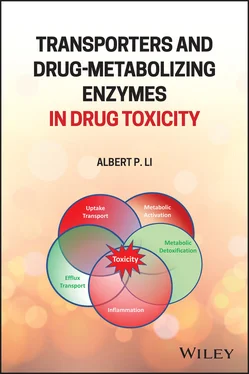Ten of the UGT1A isoforms (1–10) are encoded by the UGT1A gene locus [98]. Currently 113 UGT1A1 variants have been cataloged by the UGT nomenclature committee. The clinically‐relevant variant UGT1A1*28 has an extra TA pair inserted into the (TA) 6repeats in the TATA box [99]. This disrupts the transcriptional regulation of UGT1A1 , and thus reduces protein expression. UGT1A1*28 carriers exhibit impaired glucuronidation of lipophilic molecules, including bilirubin, resulting in decreased bilirubin clearance (Gilbert’s syndrome) [98, 100].). It has been associated with the toxicity of the anticancer drug irinotecan [101]. Irinotecan is a prodrug that undergoes bioactivation into active metabolite SN‐38, followed by inactivation by glucuronidation. The therapeutic window of irinotecan is rather small. Patients with UGT1A1*28 alleles could be at increased risk of adverse drug reactions due to its less effective clearance. Some SNPs in the UGT1A locus (e.g. C908G in the 3′‐UTR region) have been reported to be associated with the hepatic toxicity of tolcapone, all of which were in significant linkage disequilibrium with the silent mutation UGT1A6‐A528G [54].
NAT2 is expressed predominantly in the liver. More than 100 NAT2 alleles are being cataloged by the Arylamine N ‐acetyltransferase Gene Nomenclature Committee. Pharmacogenetic studies of NAT2 largely have focused on the anti‐tuberculosis drug isoniazid. NAT2 is critical to the clearance of isoniazid and its metabolites, including acetylhydrazine and hydrazine, which have been associated with hepatotoxicity [102, 103]. Patients carrying NAT2 variants with decreased enzymatic function (slow acetylator) have been reported to have higher isoniazid exposure and increased risk of DILI during anti‐tuberculosis treatment [52, 104, 105]. This suggests that genotype‐based dosing for isoniazid might be of clinical relevance. In addition to the NAT2 pathway, an alternative pathway comprised of CYP2E1 and GST plays a role in the clearance of isoniazid. CYP2E1 polymorphisms also have a suggested association with isoniazid hepatotoxicity [51, 106], however, with inconsistent evidence [104, 107]. The pharmacogenetic association remains uncertain.
2.5.9 Hepatic Transporters
Certain genetic polymorphisms in drug transporter genes have been associated with increased DILI risk. In a study comparing 33 DILI patients and 95 European controls, Lang et al. sequenced ABCB11 and ABCB4 , which encode BSEP and MDR3, and found four nonsynonymous mutations significantly associated with DILI, one of which resulted in a nonfunctional protein ( ABCB11 , exon 21: 2563G>A→G855R) [60]. Ciccacci et al. identified a variant in MDR1 (c.3435C>T) associated with nevirapine‐induced hepatoxicity in a study of 78 nevirapine‐induced hepatoxicity cases and 78 patients without hepatoxicity in Mozambique [108]. Another study found evidence that certain MDR1 polymorphisms can influence the basal CYP3A4 expression or function, i.e. individuals homozygous for MDR1 2677T (Ser893) had a higher hepatic expression or function of CYP3A4 than those homozygous for 2677G (Ala893) [109]. Daly et al. found that a variant in ABCC2 , which encodes MRP2, was significantly associated with diclofenac‐induced hepatoxicity in a European population [55]. Interestingly, this same variant, ABCC2 C‐24T, was associated with a higher clearance rate and a shorter half‐life of deferasirox in the Chinese population [61]. A study of 94 drug‐ and herb‐induced hepatoxicity cases identified several polymorphisms in ABCC2 that were associated with susceptibility to liver injury in the Korean population [110].
Increasing evidence suggests that drug metabolism and hepatic transporters play essential roles in the development of hepatotoxicity. The formation of chemically‐RMs and the abnormal accumulation of toxic bile acids or drug metabolites are two proven mechanisms causing DILI. The formation of RMs is a byproduct of physiological biotransformation of phases I and II metabolism enzymes, while bile acid accumulation results from abrupted functions of the hepatic transporters. Some of these drug‐metabolizing enzymes and hepatic transporters have significantly varied expression levels among individuals, which can lead to outcomes other than the development of DILI. In addition to the gene variations summarized in this chapter, many environmental and host factors; such as age, gender, co‐medications, comorbidities, and life‐style all affect the susceptibility of individuals through the disturbance of drug‐metabolizing enzymes and hepatic transporters. The contribution of these factors has been well‐reviewed in the literature [111, 112] and the nature of the co‐factors in these events has led to the “multiple determinants hypothesis” for idiosyncratic drug toxicity [113]. Further investigations are still needed to establish the association between interactions of these factors and their contributions to the development of DILI.
The authors thank Joanne Berger with the FDA Library for manuscript editing assistance.
The views expressed in this manuscript do not necessarily represent those of the U.S. Food and Drug Administration.
1 1 Olson H, Betton G, Robinson D, Thomas K, Monro A, Kolaja G, et al. Concordance of the toxicity of pharmaceuticals in humans and in animals. Regulatory Toxicology and Pharmacology 2000; 32(1): 56–67.
2 2 Chen M, Suzuki A, Thakkar S, Yu K, Hu C, Tong W. DILIrank: the largest reference drug list ranked by the risk for developing drug‐induced liver injury in humans. Drug Discovery Today 2016; 21(4): 648–53.
3 3 Chen M, Vijay V, Shi Q, Liu Z, Fang H, Tong W. FDA‐approved drug labeling for the study of drug‐induced liver injury. Drug Discovery Today 2011; 16 (15–16): 697–703.
4 4 Watkins P. Drug safety sciences and the bottleneck in drug development. Clinical Pharmacology & Therapeutics 2011; 89(6): 788–90.
5 5 US FDA. Drug‐Induced Liver Injury: Premarketing Clinical Evaluation; 2009. Available from: https://www.fda.gov/regulatory‐information/search‐fda‐guidance‐documents/drug‐induced‐liver‐injury‐premarketing‐clinical‐evaluation.
6 6 Zanger UM, Schwab M. Cytochrome P 450 enzymes in drug metabolism: regulation of gene expression, enzyme activities, and impact of genetic variation. Pharmacology & Therapeutics 2013; 138(1): 103–41.
7 7 Uetrecht JP, editor Myeloperoxidase as a Generator of Drug Free Radicals. Biochemical Society Symposia; 1995: Portland Press Limited.
8 8 Srivastava A, Maggs J, Antoine D, Williams D, Smith D, Park B. Role of reactive metabolites in drug‐induced hepatotoxicity. In: Uetrecht JP, editor Adverse Drug Reactions; 2010: Springer. p. 165–94.
9 9 Bischoff R, Schlüter H. Amino acids: chemistry, functionality and selected non‐enzymatic post‐translational modifications. Journal of Proteomics 2012; 75(8): 2275–96.
10 10 Walgren JL, Mitchell MD, Thompson DC. Role of metabolism in drug‐induced idiosyncratic hepatotoxicity. Critical Reviews in Toxicology 2005; 35(4): 325–61.
11 11 Dahms M, Spahn‐Langguth H. Covalent binding of acidic drugs via reactive intermediates: detection of benoxaprofen and flunoxaprofen protein adducts in biological material. Die Pharmazie 1996; 51 (11): 874–81.
12 12 FDA TU. Safety Testing of Drug Metabolites Guidance for Industry; 2020. Available from: https://www.fda.gov/media/72279/download.
Читать дальше












